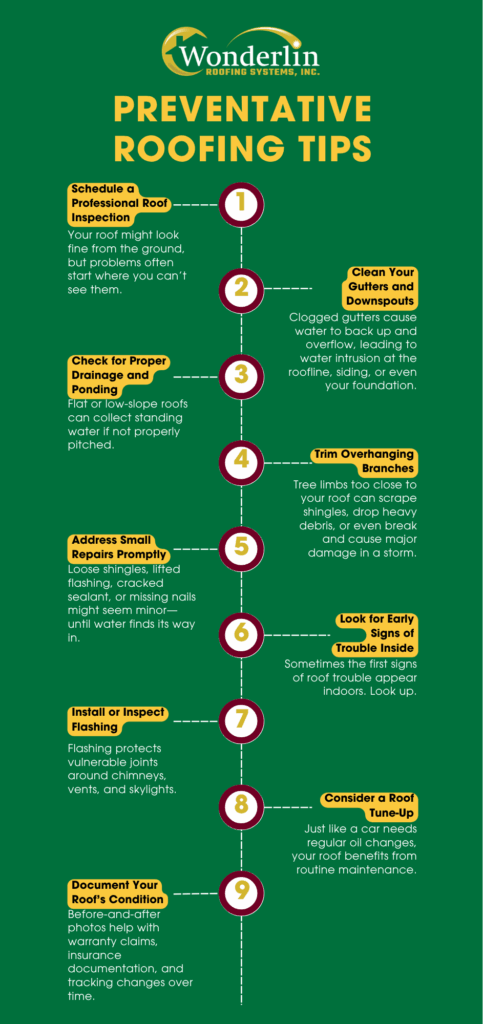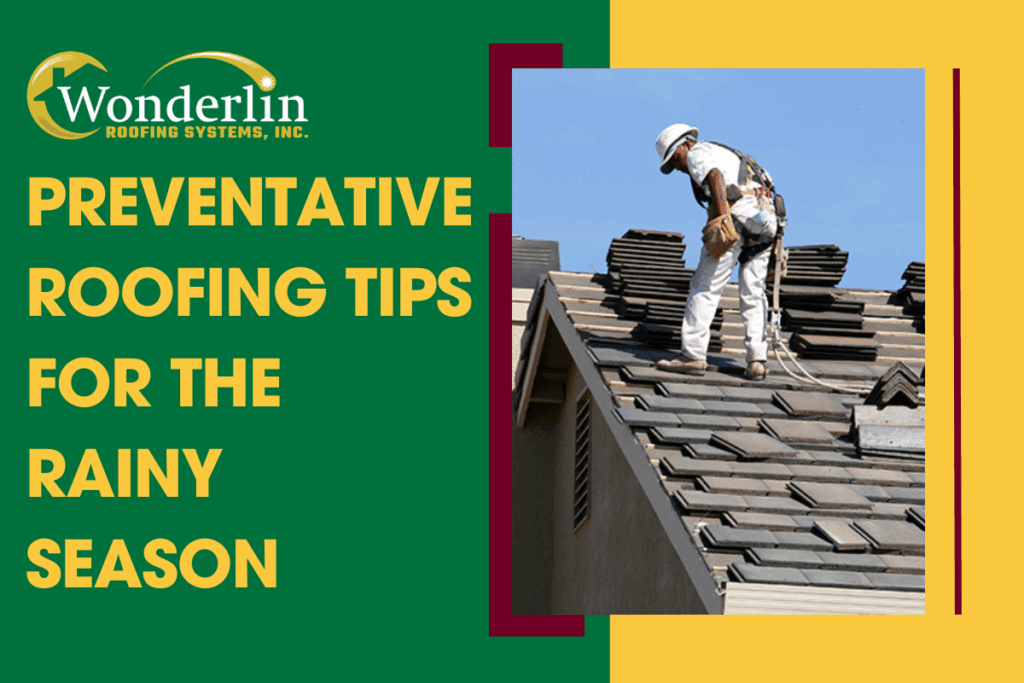As the skies darken and the rains roll in, there’s one thing every East Bay homeowner counts on: a solid, leak-free roof. At Wonderlin Roofing Systems, we know that a little preparation goes a long way. That’s why we’ve put together this practical guide to help you prepare your roof for the rainy season—because a roof isn’t just a roof. It’s peace of mind.

Schedule a Professional Roof Inspection
Your roof might look fine from the ground, but problems often start where you can’t see them. A pre-season inspection helps spot issues like loose shingles, rusted flashing, clogged gutters, or weakened sealant before they become expensive leaks.
Benefit: A professional eye can catch small issues early, preventing major damage down the line.
Pro Tip: Schedule inspections before the first heavy rains hit. Fall or early winter is ideal.
Real World Example: One of our Castro Valley clients called us last December after noticing a small stain on their living room ceiling. A quick inspection revealed a damaged vent boot—a $150 fix that saved them from a $3,000 ceiling and insulation repair.
Clean Your Gutters and Downspouts
Clogged gutters cause water to back up and overflow, leading to water intrusion at the roofline, siding, or even your foundation. Make it a habit to clean out leaves, debris, and moss at least twice a year—and especially before the rains begin.
Benefit: Clear gutters direct water away from your home, reducing the risk of leaks, rot, and erosion.
Maintenance Tip: Add leaf guards to minimize future clogging.
DIY Tip: Use a plastic scoop and garden hose with a spray nozzle. Flush each downspout to ensure flow. If water doesn’t exit freely, you may have a clog inside.
Check for Proper Drainage and Ponding
Flat or low-slope roofs can collect standing water if not properly pitched. This standing water can weaken roofing materials and increase leak risks.
Solution: Look for signs of ponding after a storm—water stains, sagging spots, or moss growth. A roofing pro can adjust pitch or improve drainage if needed.
Expert Insight: We often see ponding over converted garages or older additions. These areas typically weren’t built with proper drainage in mind.
Trim Overhanging Branches
Tree limbs too close to your roof can scrape shingles, drop heavy debris, or even break and cause major damage in a storm.
Safety Step: Keep branches at least 10 feet from your roof. This also deters critters from gaining roof access.
Bonus: Less organic matter falling on your roof means fewer clogged gutters.
Safety Note: Hire a licensed arborist for tall trees. DIY pruning can be dangerous without the right gear and training.
Address Small Repairs Promptly
Loose shingles, lifted flashing, cracked sealant, or missing nails might seem minor—until water finds its way in.
Why It Matters: Water intrusion can damage insulation, framing, ceilings, and walls. Mold and rot love a neglected roof.
Next Step: Call a roofing expert the moment you see signs of wear. Wonderlin Roofing Systems offers stress-free repair scheduling.
Customer Story: A homeowner in Hayward delayed a repair on a missing shingle. Two storms later, water damaged their attic insulation and drywall. What could’ve been a $300 fix became a $2,200 repair.
Look for Early Signs of Trouble Inside
Sometimes the first signs of roof trouble appear indoors. Look up.
Warning Signs: Water stains on ceilings, bubbling paint, musty smells, or visible mold.
What To Do: If you spot any of these, act fast. They often signal a leak that’s already doing damage.
Additional Advice: Don’t ignore paint bubbles near the ceiling. They often hide growing moisture problems.
Install or Inspect Flashing
Flashing protects vulnerable joints around chimneys, vents, and skylights. When it’s damaged, water can seep in silently.
Quick Tip: Rust, separation, or lifting means it’s time for repair or replacement.
Good To Know: We install flashing with every reroof, but it wears faster than shingles, so regular checks are key.
Consider a Roof Tune-Up
Just like a car needs regular oil changes, your roof benefits from routine maintenance.
What It Includes: Securing loose shingles, sealing exposed nails, patching small leaks, clearing debris.
Who It’s For: Ideal for roofs over 5 years old or anyone not ready for full replacement.
Frequency: We recommend a tune-up every 3-5 years to extend the lifespan of your roofing system.
Document Your Roof’s Condition
Before-and-after photos help with warranty claims, insurance documentation, and tracking changes over time.
Helpful Hint: Take clear photos of all roof planes and close-ups of repairs. Keep a folder (digital or paper) with dates and contractor notes.
Insider Tip: If your roof is under warranty, some manufacturers require visual records for claims. Documentation is your best friend.
Conclusion: Don’t Wait for the Storm to Act
Rain is coming. And while you can’t stop the weather, you can prevent the stress that comes from roof leaks and water damage. At Wonderlin Roofing Systems, we believe in doing things the right way—honest work, real solutions, no shortcuts. Trust built on generations.
Learn More about Roof Inspections and Preventative Maintenance
FAQs
How often should I have my roof inspected?
We recommend at least once a year, and again after major storms.
Can I clean my own gutters?
Yes, but be safe. Use a sturdy ladder and gloves. For second-story gutters or heavy buildup, consider hiring a pro.
How do I know if I have a drainage issue on my roof?
Signs include standing water, water stains, or visible sagging after rain.

